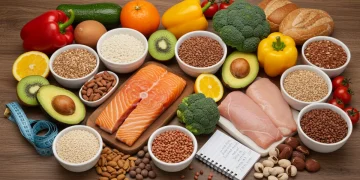Glycemic Index: Healthy Eating in 2025 – Insider Solutions

Understanding the glycemic index is essential for modern healthy eating, offering practical solutions to manage blood sugar, enhance energy, and prevent chronic diseases by making informed food choices.
In an era saturated with dietary trends and quick fixes, the fundamental principles of nutrition often get lost. However,
decoding the glycemic index: why it still matters for healthy eating in 2025 (insider knowledge, practical solutions)
remains a cornerstone for anyone serious about long-term health. This isn’t just about managing diabetes; it’s about optimizing your energy, mood, and overall well-being by understanding how foods impact your blood sugar. Let’s delve into why this often-misunderstood concept is more relevant than ever.
The enduring relevance of the glycemic index
The glycemic index (GI) concept, introduced decades ago, continues to be a powerful tool for understanding how different carbohydrate-containing foods affect blood glucose levels. In 2025, with increasing rates of metabolic disorders and a growing awareness of personalized nutrition, its relevance has only intensified. It’s not just about avoiding sugar; it’s about making smarter choices within the entire carbohydrate spectrum.
Many people still view all carbohydrates as equal, leading to confusion and suboptimal dietary strategies. The GI offers a nuanced perspective, differentiating between foods that cause rapid spikes in blood sugar and those that lead to a more gradual, sustained release of energy. This distinction is vital for maintaining stable energy levels, preventing cravings, and supporting metabolic health.
Beyond basic carbohydrates: understanding food matrices
- Processing Matters: Highly processed foods, even if derived from whole grains, often have a higher GI due to the breakdown of their fiber content.
- Fiber Content: Foods rich in fiber, like whole fruits and vegetables, typically have a lower GI because fiber slows down sugar absorption.
- Fat and Protein: The presence of fat and protein in a meal can significantly lower the overall glycemic response, even for foods that are individually high on the GI scale.
Understanding these factors allows for a more holistic approach to meal planning, moving beyond simply looking up a food’s individual GI value. It encourages us to think about how foods interact within a meal. This integrated perspective is crucial for effective blood sugar management and forms the foundation of truly healthy eating in 2025.
The enduring relevance of the glycemic index lies in its ability to provide actionable insights into food choices that directly impact our physiology. It empowers individuals to take control of their metabolic health, moving away from restrictive diets toward a more informed and sustainable approach to nutrition. By focusing on whole, unprocessed foods and understanding their glycemic impact, we can cultivate better health outcomes.
Navigating the GI scale: low vs. high GI foods
Navigating the glycemic index scale can initially seem complex, but it simplifies significantly once you understand the basic categories. Foods are typically classified as low (GI 55 or less), medium (GI 56-69), or high (GI 70 or more). This classification helps in making informed decisions about which carbohydrates to prioritize for stable blood sugar and sustained energy.
Low GI foods are digested and absorbed slowly, leading to a gradual rise in blood sugar and insulin levels. This promotes satiety, helps control appetite, and supports weight management. Conversely, high GI foods cause a rapid surge in blood sugar, which can lead to energy crashes, increased hunger, and, over time, a higher risk of insulin resistance and type 2 diabetes.
Practical examples for daily meals
- Low GI Choices: Include foods like oats (steel-cut), most non-starchy vegetables, legumes (lentils, chickpeas), berries, apples, and whole-grain bread (sourdough or dense rye).
- Medium GI Choices: Potatoes (sweet potato often lower than white), brown rice, whole wheat bread, and bananas.
- High GI Foods to Moderate: White bread, white rice, sugary cereals, instant oatmeal, and many processed snacks.
It’s important to remember that the GI of a food isn’t static; it can be influenced by cooking methods, ripeness (for fruits), and how it’s combined with other foods. For instance, pairing a medium GI food with healthy fats or proteins can effectively lower the overall glycemic response of the meal. This flexibility is key to integrating GI principles into a diverse and enjoyable diet.
Ultimately, the goal isn’t to eliminate all high GI foods but to understand their impact and consume them strategically. Focusing on a diet rich in low GI foods provides a stable foundation for energy and health. By consciously choosing lower GI options, individuals can experience better blood sugar control, improved mood, and sustained vitality throughout the day.
The glycemic load: a more complete picture
While the glycemic index provides valuable information about how quickly a carbohydrate raises blood sugar, it doesn’t account for the quantity of carbohydrates consumed. This is where the glycemic load (GL) comes into play, offering a more comprehensive understanding of a food’s impact on blood sugar. The GL considers both the quality (GI) and quantity of carbohydrates in a serving.
The GL is calculated by multiplying the GI of a food by its carbohydrate content (in grams) per serving, then dividing by 100. This calculation provides a more realistic measure of how a typical serving of food will affect blood glucose levels. A food might have a high GI but a low GL if its typical serving size contains very few carbohydrates, such as watermelon.

Why GL offers superior insights
- Portion Size Accountability: GL inherently factors in how much you’re actually eating, which GI alone doesn’t.
- Better for Mixed Meals: It helps in assessing the overall impact of a meal composed of various ingredients with different GIs and carbohydrate counts.
- Reduced Misinterpretation: Prevents misunderstandings where a high GI food with low carb density is mistakenly avoided.
For example, while carrots have a moderately high GI, their carbohydrate content per typical serving is low, resulting in a low GL. This means a serving of carrots will have a minimal impact on blood sugar, despite their GI value. This distinction is critical for debunking common myths and empowering more accurate dietary planning.
Incorporating the glycemic load into your nutritional strategy provides a more accurate and practical framework for managing blood sugar. It moves beyond simplistic labels and encourages a deeper understanding of food composition and portion control. By focusing on both GI and GL, individuals can fine-tune their diets for optimal health and energy stability, particularly crucial for those managing diabetes or seeking weight control.
GI and weight management: a powerful connection
The relationship between the glycemic index and weight management is profound and often overlooked. Diets rich in high GI foods can lead to frequent blood sugar spikes and crashes, triggering increased hunger and cravings, especially for more carbohydrates. This cycle can make it incredibly difficult to maintain a healthy weight or achieve weight loss goals.
Conversely, a diet emphasizing low GI foods promotes stable blood sugar levels, which helps in controlling appetite and extending feelings of fullness. When blood sugar is steady, the body is less likely to store excess glucose as fat, and it can more efficiently use stored fat for energy. This creates a more favorable environment for weight loss and maintenance.
How low GI diets support weight loss
- Enhanced Satiety: Slower digestion of low GI foods keeps you feeling full longer, reducing the urge to snack between meals.
- Reduced Cravings: Stable blood sugar minimizes the peaks and valleys that often trigger intense cravings for sugary or high-carb foods.
- Improved Fat Metabolism: Consistent blood sugar levels encourage the body to burn fat for fuel rather than constantly relying on quick glucose spikes.
Beyond just caloric restriction, focusing on the glycemic quality of carbohydrates can be a game-changer for weight management. It’s not just about eating less; it’s about eating smarter. Making conscious choices to include more low GI options like whole grains, legumes, fruits, and non-starchy vegetables can lead to sustainable weight loss without feeling deprived.
The connection between GI and weight management highlights the importance of not just what you eat, but how your body processes it. By integrating low GI principles into your diet, you’re not just losing weight; you’re cultivating a healthier metabolic state that supports long-term well-being and energy balance. This makes the glycemic index an indispensable tool in any effective weight management strategy.
Beyond diabetes: GI’s impact on chronic diseases
While the glycemic index is widely recognized for its role in diabetes management, its influence extends far beyond, impacting the risk and progression of several other chronic diseases. A diet consistently high in rapidly absorbed carbohydrates can contribute to systemic inflammation, oxidative stress, and insulin resistance, all of which are underlying factors in many modern health conditions.
Research suggests that diets with a high glycemic load may increase the risk of cardiovascular disease, certain types of cancer, and even neurodegenerative disorders. The constant demand on the pancreas to produce insulin in response to high GI meals can lead to pancreatic fatigue over time, further exacerbating metabolic dysfunction and increasing disease susceptibility.

GI and specific health conditions
- Cardiovascular Health: High GL diets can negatively impact cholesterol levels, blood pressure, and arterial health.
- Inflammation: Frequent blood sugar spikes can promote chronic low-grade inflammation, a precursor to many diseases.
- Energy and Mood: Stable blood sugar from low GI foods can prevent mood swings and improve cognitive function.
Adopting a low GI eating pattern can be a proactive strategy for disease prevention. It supports a healthy inflammatory response, helps maintain stable energy levels, and reduces the overall metabolic burden on the body. This approach fosters an internal environment conducive to health and resilience against chronic illness.
The impact of the glycemic index on chronic diseases underscores its importance as a foundational principle of healthy eating. By making informed choices about carbohydrate quality, individuals can significantly reduce their risk factors for a range of serious health issues, promoting longevity and a higher quality of life. It’s a testament to how seemingly simple dietary adjustments can have far-reaching health benefits.
Practical solutions for integrating GI into your diet
Integrating glycemic index principles into your daily diet doesn’t require drastic overhauls but rather thoughtful adjustments and informed choices. The key is to focus on small, consistent changes that build up over time, making healthy eating a sustainable lifestyle rather than a temporary diet. Understanding the GI is a tool, not a rigid rulebook.
Start by familiarizing yourself with the GI values of common foods you consume regularly. There are numerous online databases and apps that can help with this. However, remember that context matters: how a food is prepared and what it’s eaten with can significantly alter its glycemic response. The goal is to lower the overall glycemic load of your meals.
Strategies for lowering your meal’s GI
- Prioritize Whole Grains: Choose steel-cut oats over instant, brown rice over white, and whole-grain bread over refined white bread.
- Increase Fiber Intake: Add plenty of non-starchy vegetables, legumes, and fruits with skins to your meals.
- Combine Carbs with Protein and Healthy Fats: Pairing carbohydrates with protein (e.g., chicken, fish, tofu) and healthy fats (e.g., avocado, nuts, olive oil) slows digestion and lowers the glycemic response.
- Vinegar and Acidic Foods: Including a vinaigrette dressing or lemon juice can help reduce the post-meal blood sugar spike.
- Mindful Cooking Methods: Cooking starchy foods like pasta al dente can result in a lower GI than overcooked versions.
These practical solutions empower you to create balanced, delicious, and blood-sugar-friendly meals without feeling restricted. It’s about making smart swaps and understanding how to combine foods for optimal metabolic health. By consistently applying these strategies, you’ll experience improved energy, better weight management, and a reduced risk of chronic diseases.
Integrating GI knowledge into your daily eating habits is a powerful step towards a healthier future. It’s about becoming an active participant in your own well-being, using scientific insights to guide your food choices. These practical solutions are designed to make healthy eating both effective and enjoyable in the long run.
Future outlook: GI in personalized nutrition
As we look towards the future of nutrition in 2025 and beyond, the glycemic index is poised to play an even more integrated role, particularly within the burgeoning field of personalized nutrition. Advances in wearable technology, continuous glucose monitoring (CGM), and genomic research are making it possible to understand individual responses to food with unprecedented precision.
No longer will a single GI value suffice for everyone. Instead, personalized GI responses will be mapped, allowing individuals to fine-tune their diets based on their unique metabolic profiles. This bespoke approach promises to unlock new levels of health optimization, moving us away from one-size-fits-all dietary recommendations.
Technological integrations and insights
- Continuous Glucose Monitors (CGMs): These devices offer real-time feedback on how specific foods and meals impact an individual’s blood sugar, allowing for immediate dietary adjustments.
- AI-driven Dietary Recommendations: Artificial intelligence can analyze CGM data, dietary logs, and even genetic information to provide highly personalized GI-based meal plans.
- Microbiome Research: Emerging evidence suggests the gut microbiome plays a significant role in an individual’s glycemic response, opening doors for microbiome-targeted dietary interventions.
This future outlook suggests a dynamic interplay between our food choices, our bodies, and advanced technology. The glycemic index, once a broad guideline, will become a highly individualized metric, enabling truly precision nutrition. This will not only improve health outcomes for those with metabolic conditions but also optimize performance and well-being for the general population.
The integration of GI into personalized nutrition represents an exciting frontier. It promises a future where dietary advice is not just generalized but specifically tailored to each individual’s unique physiological responses. This evolution will cement the glycemic index’s place as a fundamental and adaptable tool for healthy eating in the years to come, offering unparalleled insights and solutions.
| Key Concept | Brief Description |
|---|---|
| Glycemic Index (GI) | Measures how quickly carbohydrate-containing foods raise blood sugar levels. |
| Glycemic Load (GL) | Considers both GI and carbohydrate quantity per serving for a realistic impact. |
| Low GI Benefits | Promotes stable blood sugar, satiety, weight management, and chronic disease prevention. |
| Practical Integration | Combine carbs with protein/fat, choose whole grains, increase fiber, and use CGMs for personalized insights. |
Frequently asked questions about the glycemic index
The glycemic index (GI) is a system that ranks carbohydrate-containing foods based on how quickly they raise blood glucose levels after eating. It’s important because understanding GI helps manage blood sugar, control appetite, and reduce the risk of chronic diseases like type 2 diabetes and heart disease.
While GI measures how quickly a food raises blood sugar, glycemic load (GL) provides a more comprehensive picture by considering both the GI of a food and its carbohydrate content per serving. GL gives a more accurate representation of a typical portion’s impact on blood sugar.
Yes, high GI foods can be part of a healthy diet, especially when consumed in moderation and combined with low GI foods, proteins, and healthy fats. This combination helps to slow down sugar absorption and reduce the overall glycemic response of the meal, balancing its impact.
To lower a meal’s GI, prioritize whole grains over refined ones, increase fiber intake from vegetables and legumes, and always pair carbohydrates with protein and healthy fats. Cooking methods, like keeping pasta al dente, can also make a difference in its glycemic impact.
Absolutely. While crucial for diabetics, the glycemic index is relevant for everyone seeking better energy levels, weight management, and reduced risk of chronic diseases. Understanding GI helps optimize overall health by promoting stable blood sugar and preventing metabolic imbalances.
Conclusion
The journey through understanding the glycemic index reveals that it is far from an outdated concept; rather, it’s a dynamic and increasingly personalized tool for optimal health in 2025. By moving beyond simplistic categorizations and embracing the nuances of glycemic load, food combinations, and individual responses, we can empower ourselves to make truly informed dietary choices. The insights gained from decoding the glycemic index offer practical solutions not only for managing blood sugar and weight but also for reducing the risk of a spectrum of chronic diseases. As technology advances, our ability to personalize nutrition based on GI principles will only grow, making it an indispensable part of a proactive approach to well-being. Embracing this knowledge allows us to cultivate a healthier, more energized future.





